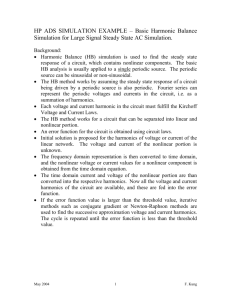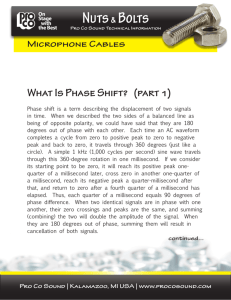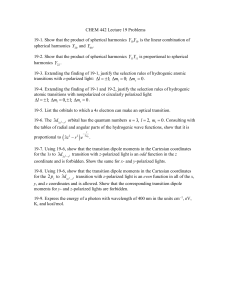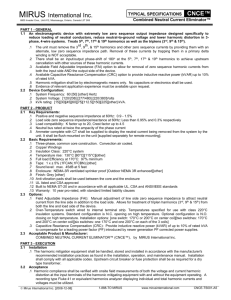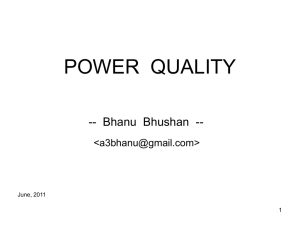Paper Title (use style: paper title)
advertisement
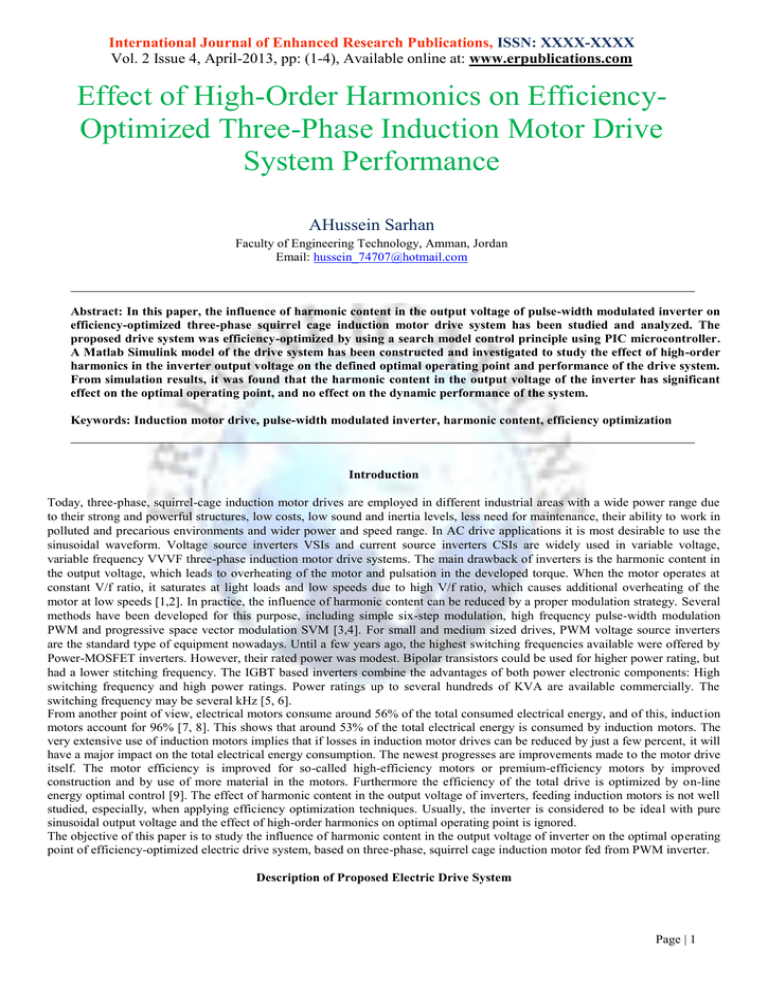
International Journal of Enhanced Research Publications, ISSN: XXXX-XXXX Vol. 2 Issue 4, April-2013, pp: (1-4), Available online at: www.erpublications.com Effect of High-Order Harmonics on EfficiencyOptimized Three-Phase Induction Motor Drive System Performance AHussein Sarhan Faculty of Engineering Technology, Amman, Jordan Email: hussein_74707@hotmail.com Abstract: In this paper, the influence of harmonic content in the output voltage of pulse-width modulated inverter on efficiency-optimized three-phase squirrel cage induction motor drive system has been studied and analyzed. The proposed drive system was efficiency-optimized by using a search model control principle using PIC microcontroller. A Matlab Simulink model of the drive system has been constructed and investigated to study the effect of high-order harmonics in the inverter output voltage on the defined optimal operating point and performance of the drive system. From simulation results, it was found that the harmonic content in the output voltage of the inverter has significant effect on the optimal operating point, and no effect on the dynamic performance of the system. Keywords: Induction motor drive, pulse-width modulated inverter, harmonic content, efficiency optimization Introduction Today, three-phase, squirrel-cage induction motor drives are employed in different industrial areas with a wide power range due to their strong and powerful structures, low costs, low sound and inertia levels, less need for maintenance, their ability to work in polluted and precarious environments and wider power and speed range. In AC drive applications it is most desirable to use the sinusoidal waveform. Voltage source inverters VSIs and current source inverters CSIs are widely used in variable voltage, variable frequency VVVF three-phase induction motor drive systems. The main drawback of inverters is the harmonic content in the output voltage, which leads to overheating of the motor and pulsation in the developed torque. When the motor operates at constant V/f ratio, it saturates at light loads and low speeds due to high V/f ratio, which causes additional overheating of the motor at low speeds [1,2]. In practice, the influence of harmonic content can be reduced by a proper modulation strategy. Several methods have been developed for this purpose, including simple six-step modulation, high frequency pulse-width modulation PWM and progressive space vector modulation SVM [3,4]. For small and medium sized drives, PWM voltage source inverters are the standard type of equipment nowadays. Until a few years ago, the highest switching frequencies available were offered by Power-MOSFET inverters. However, their rated power was modest. Bipolar transistors could be used for higher power rating, but had a lower stitching frequency. The IGBT based inverters combine the advantages of both power electronic components: High switching frequency and high power ratings. Power ratings up to several hundreds of KVA are available commercially. The switching frequency may be several kHz [5, 6]. From another point of view, electrical motors consume around 56% of the total consumed electrical energy, and of this, induction motors account for 96% [7, 8]. This shows that around 53% of the total electrical energy is consumed by induction motors. The very extensive use of induction motors implies that if losses in induction motor drives can be reduced by just a few percent, it will have a major impact on the total electrical energy consumption. The newest progresses are improvements made to the motor drive itself. The motor efficiency is improved for so-called high-efficiency motors or premium-efficiency motors by improved construction and by use of more material in the motors. Furthermore the efficiency of the total drive is optimized by on-line energy optimal control [9]. The effect of harmonic content in the output voltage of inverters, feeding induction motors is not well studied, especially, when applying efficiency optimization techniques. Usually, the inverter is considered to be ideal with pure sinusoidal output voltage and the effect of high-order harmonics on optimal operating point is ignored. The objective of this paper is to study the influence of harmonic content in the output voltage of inverter on the optimal operating point of efficiency-optimized electric drive system, based on three-phase, squirrel cage induction motor fed from PWM inverter. Description of Proposed Electric Drive System Page | 1 International Journal of Enhanced Research Publications, ISSN: XXXX-XXXX Vol. 2 Issue 4, April-2013, pp: (1-4), Available online at: www.erpublications.com The proposed drive system is shown in Fig. 1. It consists of three-phase, squirrel-cage induction motor, fed from IGBT-inverterbased AC-to-AC energy converter, constant torque Load and controller. Figure 1. Block diagram of proposed electric drive system. The controller operates according to constant V/f ratio to maintain the loading capacity (maximum torque) of the system constant. The motor ratings and parameters are given in Tab. 1. Table 1: Induction Motor Ratings and Parameters Parameter Nominal power, Pn nn Nominal voltage, V1n ( L L ) Nominal speed, Nominal current, In Nominal torque, Tn fn Nominal frequency, Value 7.5 kW 1440rpm 400V 18.75 A 49.74N.m 50Hz Number of poles, p 4 Stator resistance, R1 Stator reactance, X 1 0.738 0.003 Rotor resistance, referred to the stator, R' 2 Rotor resistance, referred to the stator, X ' 2 0.740 Moment of inertia, J 0.003 0.034kg.m 2 Page | 2 International Journal of Enhanced Research Publications, ISSN: XXXX-XXXX Vol. 2 Issue 4, April-2013, pp: (1-4), Available online at: www.erpublications.com The inverter is considered ideal without harmonic content, except the fundamental harmonic, in its output voltage. The control command is the modulation index m=V1/Vn . This system is to be efficiency optimized. The block-diagram of the optimized system is shown in Fig. 2. Figure 2. Block diagram of efficiency-optimized electric drive system. Efficiency optimization is provided according to the search principle control, where the total power losses in the system is minimized by trial and error. For this purpose, a PIC microcontroller PIC-16F877A was used to find the optimal value of modulation index mopt , corresponding to minimum (optimal) losses . The controller operates according to the flow chart shown in Fig. 3 [9]. The total power losses P in the system can be treated as the difference between the input power the output mechanical power Pin , supplied to the stator, and Po : P Pin Po The input power supplied to the stator (1) Pin and the mechanical output power Po can be calculated by the following equations [8,9]: 3 Pin [( I sqVsq ) ( I sdVsd )] 2 Po TL where I sq , I sd , Vsq , Vsd the d and q components of stator current and voltage, TL (2) (3) the load torque, and the angular rotational speed. The efficiency of the system is defined as: Po Pin (4) Page | 3 International Journal of Enhanced Research Publications, ISSN: XXXX-XXXX Vol. 2 Issue 4, April-2013, pp: (1-4), Available online at: www.erpublications.com Figure 3. Optimization algorithm for search control. To evaluate the influence of the high-order harmonics on the system behavior, the output voltage of the inverter can be treated as [6]: vout (t ) Vm1 sin( t 1 ) Vm3 sin( 3t 3 ) Vm5 sin( 5t 5 ) ... (5) The rms value of inverter output voltage can be calculated as: Vout V 2 m1 V 2 m 2 V 2 m3 ... 2 (6) and the modulation index will be defined as: m Vout 1 Vn (7) The magnitudes of high-order harmonics as a percent of the magnitude of fundamental (first) harmonic are given in Tab. 2 [3]. Page | 4 International Journal of Enhanced Research Publications, ISSN: XXXX-XXXX Vol. 2 Issue 4, April-2013, pp: (1-4), Available online at: www.erpublications.com Table 2: Magnitudes of High-Order Harmonics as a Percent of the Magnitude of Fundamental Harmonic Harmonic Order 3rd Value 7% 5th 4% 7 th 2% 9 th 1% 11 th 0.5% In this case, the search algorithm will remain the same, but the value of V1 will be calculated by equation (6), which means that the value of modulation index will be increased, and when the system operates at frequencies near to the base frequency (50Hz), the optimization technique will not work, because the input voltage to the stator could not exceed the nominal value. In this study, the effect of harmonics higher than 5th order was neglected because of their low weight, compared with the fundamental one. Simulation Results The Matlab SIMULINK model of the proposed drive system was constructed and investigated. Simulation results were compared and analyzed. As indicators for steady state performance analysis, power factor, total power losses and efficiency were considered. Analysis was provided for different operating conditions. Tabs. (3, 4) and Figs. (4, 5) illustrate the effect of high harmonics on efficiency-optimized system. It was noticed that high-order harmonics at the whole range of frequencies and load torque decrease the efficiency of optimized system due to increase in total power losses, so, it is not recommended to consider the inverter as ideal when dealing with efficiency optimization, and the effect of high-order harmonics should be taken into consideration. Table 3: Harmonic Effect on Total Power Losses Load Torque, N.m 1 10 20 30 50 Frequency, 50Hz Without harmonics With harmonics 19.33W 20W 78.41W 100W 152.4W 207.8W 233.6W 327W 476.9W 695.4W Frequency, 20Hz Without harmonics With harmonics 14.67W 19.86W 57.54W 149.9W 135.1W 212W 229.6W 391W 572.9W 1001W Table 4: Harmonic Effect on Efficiency Load Torque, N.m 1 10 20 30 50 Frequency, 50Hz Without harmonics With harmonics 0.891 0.889 0.953 0.932 0.954 0.937 0.954 0.938 0.963 0.941 Frequency, 20Hz Without harmonics With harmonics 0.811 0.760 0.917 0.810 0.913 0.817 0.921 0.818 0.936 0.825 Page | 5 International Journal of Enhanced Research Publications, ISSN: XXXX-XXXX Vol. 2 Issue 4, April-2013, pp: (1-4), Available online at: www.erpublications.com Figure 4. Effect of harmonics on total power losses. (1 for 50Hz without harmonics, 2 for 50Hz with harmonics, 3 for for 20Hz without harmonics, 4 for 20Hz with harmonics) Figure 5. Effect of harmonics on efficiency. (1 for 50Hz without harmonics, 2 for 50Hz with harmonics, 3 for for 20Hz without harmonics, 4 for 20Hz with harmonics) Figs. (6, 7) show the dynamic response of the system at TL 20N.m and f1 20Hz , from which it is clear that high-order harmonics do not have significant effect on the dynamic performance of the system. Page | 6 International Journal of Enhanced Research Publications, ISSN: XXXX-XXXX Vol. 2 Issue 4, April-2013, pp: (1-4), Available online at: www.erpublications.com Figure 6. Dynamic response for angular rotational speed (1 without harmonics, 2 with harmonics). Figure 7. Dynamic response for electromagnetic torque (1 without harmonics, 2 with harmonics). Conclusion In this paper, the influence of harmonic content in the output voltage of inverter has been studied. It was found that the harmonic content significantly affects the optimal operating point of the electric drive system and reduces its efficiency. Thus, the effect of high-order harmonics should be considered when designing the optimal control algorithm of the electric drive system. Also, it was noticed that high harmonic content, practically, has no effect on the dynamic response of the system. Page | 7 International Journal of Enhanced Research Publications, ISSN: XXXX-XXXX Vol. 2 Issue 4, April-2013, pp: (1-4), Available online at: www.erpublications.com References [1] Berrezzek Farid, A, "Study of New Techniques of Controlled PWM Inverters," European Journal of Scientific Research, vol. 32, No.1, pp.77-87, 2009. [2] C.U. Ogbuka and M.U. Agu,"A generalized rectified sinusoidal PWM technique for harmonic elimination," The Pacific Journal of Science and Technology, vol. 10. No. 2, pp. 21-26, 2009. [3] Holtz, J. ‘‘Pulse width modulation-a survey’’, IEEE Transaction Industrial Electronics. Vol. 39, No. 5, pp. 410-420, 1992. [4] Zhou K, andWang D, "Relationship between space- vector modulat. and three-phase carrier-based PWM",: A Compheren. Anal. IEEE Trans. Ind. Elect., vol. 49, No. 1, pp. 186-196, 2002. [5] Metin Doğan, Mustafa Dursun, Ali Fuat Boz and Gökhan Poyraz, "Optimization of harmonics formed in asynchronous motors through SPWM and genetic algorithms", International Journal of the Physical Sciences, vol. 6, No. 1, pp. 4008-4019, 2011. [6] Valery Vodovozov and Tõnu Lehtla, "Ways to reduce switching losses in motor drive inverters", 10th International Symposium, "Topical Problems in the Field of Electrical and Power Engineering", Pärnu, Estonia, pp. 3-9, January 10-15, 2011. [7] Hussein Sarhan, "Energy efficient control of three-phase induction motor drive", Energy and Power Engineering, vol. 3, pp. 107-112, 2011. [8] Hussein Sarhan, Rateb Issa, Mohammad Alia and Jamal M. Assbeihat, "Slip compensation in efficiency-optimized three-phase induction motor drive systems", Intelligent Control and Automation, vol. 2, pp. 95-99, 2011. [9] Hussein Sarhan, "Online energy efficient control of three-phase induction motor drive using PIC-microcontroller", International Review on Modeling and Simulation (I.RE.MO.S), Vol. 4, No 5, pp. 2278-2284, 2011. Page | 8

